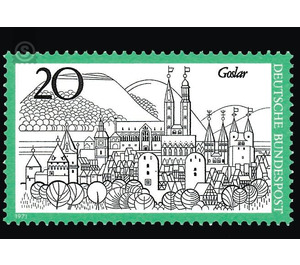tourism - Germany / Federal Republic of Germany 1971 - 20 Pfennig
Theme: Architecture
| Country | Germany / Federal Republic of Germany |
| Issue Date | 1971 |
| Face Value | 20.00 |
| Color | grey green |
| Perforation | K 14 |
| Printing Type | Intaglio and offset printing |
| Stamp Type | Postage stamp |
| Item Type | Stamp |
| Chronological Issue Number | 593 |
| Chronological Chapter | GER-BRD |
| SID | 633880 |
| In 67 Wishlists | |
Since 1969, the Deutsche Bundespost has published a series of special stamps over several years devoted to places or areas of tourism. As part of this series, the special stamp "Goslar" is now published. A millennium of German history is reflected in the cityscape of the old imperial, imperial and Hanseatic city. In 922 it was founded by Henry I. Among his successors was the proud Imperial Palatinate, where in the 11th and 12th centuries the emperors often held court and, together with the German princes, made important decisions at the Diet. At the end of the Middle Ages the free imperial and Hanseatic city of Goslar, thanks to the rich mining of its ore mines, attained great power and a considerable height of bourgeois culture. Goslar's medieval old town is bursting with busy life today. The city has long outgrown the wall of the medieval wall ring and has developed into a modern community. The strangers are attracted to Goslar treasures of ancient art and culture, the undamaged medieval cityscape and the forests of the Harz.


